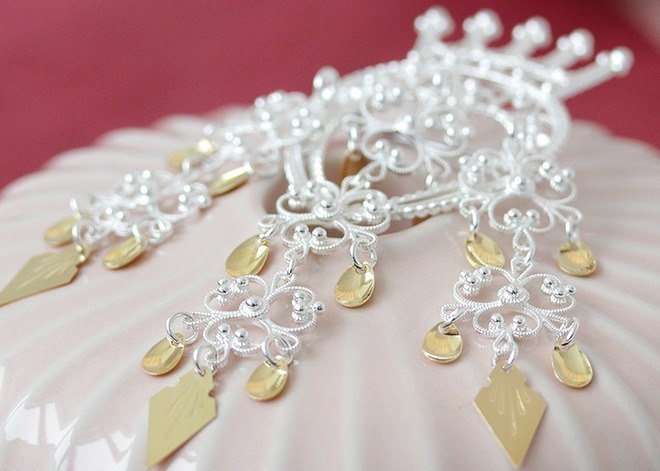
From feminine dishes to sacred figures
Maybe you've admired the brooch and thought how beautiful it is. But have you ever wondered why it looks like it does?
The messages concealed in the brooches
The shapes, figures and numbers are not put together at random , although the hidden language of the brooch is not something that many people know about any more.
While today there is more value on the aesthetics, the symbolism of the brooches was important in the Middle Ages. Figures and shapes were associated with superstition and magic in a natural relationship to the worldview and the existential.
Yes please, both
Mythology and religion form the basis of the symbolism of the bunad silver and many of the symbols found in the brooches are up to 5,000-6,000 years old. Following the introduction of Christianity to this country, Christian values were assigned to the pagan symbols. They often overlap each other and people often believed in both. At the time, there was the belief that the magic or power would work, regardless of whether you believed in one or the other!
Brooches with different pendants and leaves
Most of the brooches have rustling pendants and leaves. Some short, others long. Leaves can have different shapes; round, cross-shaped, drop-shaped and spire-shaped.
The feminine dishes
Brooches with round leaves, or dishes as they are also called, have a rose base. Six kidney-shapes that are set together in a ring. Such brooches are called rose brooches or dish brooches.
Face brooches and some serpent brooches also have round dishes.
Silver dishes have a feminine symbolism and express virginity.
Dish brooches were given as engagement gifts by the boy. The bigger the brooch - the more dishes and apparently a sign of how much the boy appreciates his chosen lady!

Cross leaves
Since the Stone Ages, the cross has probably been the most commonly used symbol across cultures.
As with a lot of other bunad silver, cross leaves have Christian origins and the shape of equilateral crosses that narrow towards the centre is more from the beginning of the Middle Ages.
Cross leaves are often embellished with engraving, coloured stones or filigree that is welded on.

Spire leaves
The symbolism associated with spire leaves goes all the way back to pre-Christian times in connection with rituals linked to fertility and strength.
In the context of Christianity, the spire symbolises God's power and strength.

Heart brooch with spire leaves, decorated with a wreath - again Christian symbolism for the divine light.
Sun dial
The sun dial is found in folk art from the Bronze Age and is likely to have been associated with agriculture. The sun dial was magical and seen in the context of both protection and fertility. In Christianity, the symbolism was associated with the divine.

Brooch for the Trønderlag bunad with 4 sun dials and 12 spire leaves
Barley grains
Some of the brooches from the Telemark region have pendants that are meant to resemble barley grain. This is an old pagan symbol of new life and fertility.

Barley grain brooch from Telemark
Drop leaves
Drop leaves are these small leaves that dangle at the bottom of the brooch. Water in a droplet form represents the Holy Spirit, purity and innocence.

Brooch with dishes, pendant and drop leaves
The holy figures
From both the structural and geometrical perspectives, there is nothing random when it comes to these beautiful brooches or the figures on their different constituent parts. Maybe you counted 6 dishes on your brooch? Or perhaps 8 or 12?
Bol brooches usually have 12 small and large bols, serpent brooches have 6 curves and Agnus Dei (chain pendant/coin pendant), have 3 pendants.
What did these figures mean at a time when the use of symbols and superstition played a big role in human life?
The heavenly figure
All figures that can be divided by 3 were seen as sacred. The number 3 is "the heavenly figure" and is a reference to the Holy Trinity - The Father, The Son and The Holy Spirit. The expression "all good things comes in threes" probably comes from this number symbolism.

Rogaland brooch with 6 cross leaves and 12 dishes
The earthly number
The number 4 and the numbers that can be divided by 4 also have special significance. It is the "earthly number" and refers to the 4 corners of the earth: north, south, east and west, the 4 seasons and the 4 elements. The number 4 also gradually took on a more Christian meaning as Christianity established itself in the country; amongst other things it refers to God’s creation of the universe on the fourth day, the 4 gospels in the Bible and Jesus who was of the clan of Judah - the fourth of a total of 12 clans.

The horn brooch has 4 "horns" that refer to the earthly number 4
The whole
numbers 7 and 10 represent the totalitarian and complete.
It is a reference to God's connection to the world. As mentioned, the number 3 is the sacred number and 4 is the earthly number. Together they total 7, which refers to the Creation.
10 is one of the "perfect" numbers. It symbolises law and order and refers to the 10 Commandments. And for those who are particularly interested: The sum total of John 3.16 (a verse in the New Testament that is called the "most famous verse of the Bible") is exactly - 10!


From left: Brooch with 7 pendants - Rogaland brooch with 10 pendants